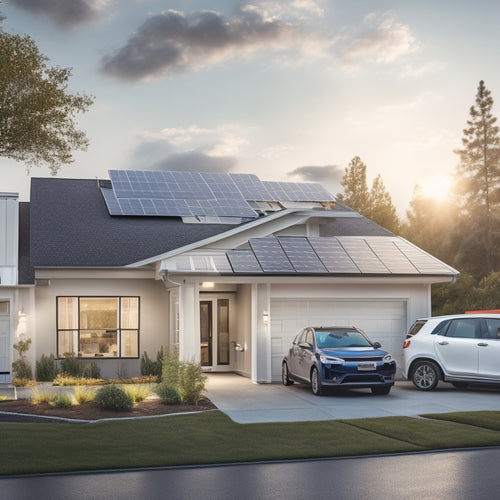
Solar Energy Storage Costs: 10 Expenses to Expect
Share
When implementing a solar energy storage system, you'll encounter 10 significant expense categories. Equipment and hardware costs include batteries, inverters, and mounting systems, while installation costs encompass labor expenses, permitting, and electrical infrastructure upgrades. Maintenance and monitoring costs, land and space acquisition, and grid connection fees also factor in. Additionally, you'll need to evaluate system specifications, potential utility upgrades, and available incentives. Each category comprises several essential components that impact your project budget, and understanding these expenses is vital for a successful and cost-effective solar energy storage system - and there's more to investigate in each of these areas.
Key Takeaways
- Equipment and hardware costs, including the battery system, inverter, and mounting systems, account for the largest share of solar energy storage costs.
- Installation costs vary depending on system complexity, labor rates, and location, with labor expenses ranging from $1,500 to $40,000.
- Maintenance and monitoring costs, including scheduled and corrective maintenance, can range from $500 to $5,000 per year, depending on system size and complexity.
- Land and space acquisition costs, including leasing or purchasing land, site preparation, and environmental impact assessments, can add significant expenses to the project.
- Incentives and rebates, such as tax credits and utility company rebates, can help offset initial costs, but researching and staying informed about policy changes is essential.
Equipment and Hardware Costs
As you investigate the world of solar energy storage, understanding the equipment and hardware costs is vital for a successful project. The battery system, including the battery itself and its associated components, accounts for the largest share of equipment costs.
The cost of batteries has decreased markedly over the years, thanks to technological advancements and economies of scale. However, the battery lifespan, typically ranging from 10 to 15 years, affects the overall cost. Energy efficiency also plays a significant role, as more efficient systems require less hardware, reducing costs.
Environmental impact is another consideration, with eco-friendly options often coming at a premium.
When evaluating equipment costs, you should also consider financing options, government incentives, and market trends. Many governments offer incentives for adopting renewable energy solutions, which can help offset costs.
Additionally, installation warranties can provide peace of mind and protect your investment. By understanding these factors, you can make informed decisions about your solar energy storage project and maximize your return on investment.
Installation Labor Expenses
With your solar energy storage project, you'll need to factor in installation labor expenses, which can vary widely depending on the complexity of the system, local labor rates, and the installer's level of skill. Labor costs can account for a significant portion of your overall expenses, so it is crucial to understand the factors that influence them.
Labor market trends, such as the availability of skilled workers and local labor regulations, can impact installation costs. Additionally, installation training programs can affect the quality and efficiency of the installation process, leading to variations in labor expenses.
Here is a breakdown of estimated labor costs for different types of solar energy storage systems:
| System Type | Labor Cost per kWh | Total Labor Cost |
|---|---|---|
| Residential | $0.15 - $0.30 | $1,500 - $3,000 |
| Commercial | $0.10 - $0.25 | $5,000 - $12,500 |
| Industrial | $0.05 - $0.20 | $10,000 - $40,000 |
Keep in mind that these estimates are rough and can vary depending on your specific project requirements and location.
Battery Type and Quality
Most solar energy storage systems rely on deep cycle batteries, which come in various types and qualities. You'll need to evaluate the benefits and drawbacks of each type to guarantee you get the right one for your system.
Lithium-ion batteries, for instance, offer high energy density, long lifespan, and low maintenance, making them a popular choice for solar energy storage. However, they can be more expensive than other options.
When selecting a battery, you'll need to assess capacity variations, which affect the system's overall performance. Look for batteries that meet safety standards and have built-in thermal management systems to prevent overheating.
You should also contemplate recycling options and the environmental impact of your choice. Additionally, take into account warranty considerations and the manufacturer's reputation for producing reliable products.
As you weigh your options, keep in mind that performance degradation over time is a natural process. However, some batteries are more resistant to degradation than others.
Technological advancements have improved battery efficiency, but it's crucial to stay informed about the latest developments to make an informed decision.
Inverter and Converter Costs
You'll need to evaluate the type of inverter used in your solar energy storage system, as different types, such as string inverters, microinverters, and power optimizers, have distinct cost profiles.
A cost breakdown analysis will help you understand the expenses associated with each component, including the inverter itself, installation, and maintenance.
Inverter Types
Several inverter types are currently available on the market, each with its unique characteristics, advantages, and disadvantages. As you investigate your options, you'll want to take into account factors like inverter efficiency, which can range from 93% to 98% depending on the technology.
Inverter warranties also vary, with some brands offering up to 25-year guarantees. You'll need to research reputable inverter brands, such as SMA, Fronius, and Enphase, to find the best fit for your system.
Inverter technologies include string inverters, microinverters, and power optimizers, each with its own strengths and weaknesses. Proper inverter sizing is vital to guarantee peak performance and minimize energy losses.
When selecting an inverter, think about its features, such as monitoring capabilities, compatibility with your solar panel array, and placement options (e.g., indoor or outdoor). Seamless inverter integration with your energy storage system is also essential.
Cost Breakdown Analysis
When calculating the total cost of your solar energy storage system, an essential step is to break down the expenses into individual components, including inverter and converter costs.
You'll want to take into account the financial incentives and tax credits that can offset these costs, as they can greatly influence your return on investment.
Inverter and converter costs typically range from $0.10 to $0.30 per watt, depending on the type and quality of the equipment.
These costs are critical to your energy independence, as they enable you to store excess energy generated by your solar panels during the day for use during the night or on cloudy days.
By investing in a high-efficiency inverter and converter, you can maximize your energy efficiency and reduce your environmental impact.
Keep an eye on market trends and policy changes, as they can affect financing options and the overall cost of your system.
Additionally, take into account the battery lifespan and replacement costs when calculating your total expenses.
Mounting and Racking Systems
Mounting and Racking Systems
Mounting and racking systems play a critical role in solar energy storage, as they securely fasten solar panels to rooftops or ground-mounted installations, guaranteeing ideal energy generation and longevity.
When selecting a mounting and racking system, you'll need to take into account the type of installation, local building codes, and environmental factors. You'll have various mounting materials to choose from, including anodized aluminum, stainless steel, and galvanized steel. Each material has its own strengths, weaknesses, and cost implications.
You'll also need to decide on racking options, such as fixed-tilt, single-axis, or dual-axis tracking systems. Fixed-tilt systems are the most common and cost-effective option, while tracking systems allow for greater energy production but at a higher cost.
Additionally, you'll need to take into account the weight and durability of the system, as well as its compatibility with your solar panels. By carefully evaluating these factors, you can guarantee a safe and efficient installation that meets your energy storage needs.
Electrical Infrastructure Upgrades
As solar energy storage systems become increasingly complex, upgrading your electrical infrastructure is essential to guarantee a seamless and efficient changeover. This is imperative to secure grid reliability and energy resilience, as outdated infrastructure can hinder the performance of your solar energy storage system.
Upgrading your electrical infrastructure involves several key components, including:
- Replacing outdated electrical panels and switchgear to handle increased power demands
- Installing new circuit breakers and fuses to prevent electrical overloads
- Upgrading wiring and cabling to support higher voltage and current ratings
- Installing monitoring and control systems to track energy production and storage
- Integrating smart grid technologies to optimize energy distribution and consumption
Permitting and Inspection Fees
Obtaining necessary permits and undergoing inspections are crucial steps in the installation of your solar energy storage system. These fees vary depending on your location, system size, and local regulations. You'll need to budget for permits, inspection fees, and potential re-inspection costs.
To guarantee regulatory compliance, you'll need to obtain permits from local authorities before commencing installation. Inspection timelines can range from a few days to several weeks, depending on the complexity of the system and the workload of local authorities.
Here's a breakdown of typical permitting and inspection fees:
| Permit/Inspection Type | Cost Range | Description |
|---|---|---|
| Building Permit | $500-$2,000 | Required for structural modifications |
| Electrical Permit | $200-$1,000 | Guarantees electrical safety and compliance |
| Fire Department Inspection | $100-$500 | Verifies system safety and compliance with fire codes |
Keep in mind that these costs are estimates, and actual fees may vary depending on your location and system requirements. It's crucial to factor these expenses into your overall solar energy storage system budget to avoid unexpected costs.
Monitoring and Maintenance Costs
When you invest in solar energy storage, you'll need to take into account the ongoing expenses associated with monitoring and maintaining your system.
You'll want to track your system's performance to guarantee it's operating at ideal levels, which will require you to budget for system performance tracking costs.
Additionally, you'll need to factor in scheduled maintenance fees to keep your system running smoothly and extend its lifespan.
System Performance Tracking
Throughout the solar energy storage system's lifespan, you'll need to keep tabs on its performance to ascertain it's operating at peak levels. This is where system performance tracking comes in – a vital aspect of guaranteeing your investment yields the desired returns.
You'll want to stay on top of your system's efficiency, monitoring performance metrics like energy yield and usage patterns. This data will help you identify areas for improvement, allowing for performance optimization and reducing energy waste.
-
Real-time monitoring enables you to respond quickly to system diagnostics, minimizing downtime and maximizing energy forecasting.
-
Advanced software solutions provide comprehensive data analytics, helping you make informed decisions about your system's operation.
-
By tracking your system's performance, you'll be able to identify opportunities to increase energy yield and reduce costs.
-
Regular monitoring also helps you detect potential issues before they become major problems.
-
With accurate performance data, you'll be able to make adjustments to optimize your system's operation and ascertain it's running at its best.
Scheduled Maintenance Fees
As you monitor your solar energy storage system's performance, you'll need to factor in the associated costs of keeping it running at peak levels. Scheduled maintenance fees are essential to guarantee your system operates efficiently and effectively. These costs include preventive maintenance, which involves regular inspections, cleaning, and replacement of worn-out parts.
| Maintenance Type | Average Cost |
| Preventive Maintenance | $500 - $1,000 per year |
| Corrective Maintenance | $1,000 - $5,000 per incident |
| Service Contracts | $2,000 - $10,000 per year |
Land and Space Acquisition
In pursuit of a solar energy storage system, acquiring land and space is an important consideration. You'll need to secure a suitable location for your system, making sure it meets your energy demands while complying with local regulations.
Land and space acquisition costs can add up quickly, so it's vital to factor them into your overall budget.
When selecting a site, consider the following key factors:
-
Land zoning and spatial planning: Verify your system complies with local zoning laws and spatial planning regulations.
-
Environmental impact: Assess the site's environmental sensitivity and potential impact on local ecosystems.
-
Land leasing or purchasing: Determine whether to lease or buy the land, considering the pros and cons of each option.
-
Site selection and accessibility: Choose a site that's easily accessible for maintenance and operation, while also considering factors like soil quality and natural resource availability.
-
Property taxes and regulatory compliance: Factor in property taxes and confirm your system meets all relevant regulatory requirements, including land use and development regulations.
Grid Connection and Interconnection
You'll need to take into account the costs associated with connecting your solar energy storage system to the grid, including interconnection application fees that can range from $5,000 to $50,000 or more, depending on the complexity of the project.
Additionally, you may need to invest in grid connection upgrades to guarantee your system meets the utility company's interconnection requirements. These upgrades can add tens of thousands of dollars to your overall project costs.
Interconnection Application Fees
Several stakeholders are involved in the interconnection process, and each one comes with a price tag. As you maneuver through the interconnection process, you'll encounter various fees that add up quickly. One of the most significant expenses is the interconnection application fee.
This fee covers the cost of processing your application, reviewing your system design, and conducting studies to guarantee your solar energy storage system meets the grid's technical requirements. The application fee can range from $500 to $5,000 or more, depending on the complexity of your system and the utility's requirements.
Here are some additional costs you may incur during the interconnection process:
-
Study fees: $1,000 to $10,000 or more for impact studies, feasibility studies, and other assessments
-
Engineering fees: $2,000 to $10,000 or more for system design, planning, and permitting
-
Metering and monitoring fees: $1,000 to $5,000 or more for installing and configuring metering and monitoring equipment
-
Permitting fees: $1,000 to $5,000 or more for obtaining necessary permits and approvals
-
Utility fees: $1,000 to $5,000 or more for utility-related expenses, such as infrastructure upgrades
Keep in mind that these fees can vary widely depending on your location, system size, and utility requirements. Be certain to factor them into your overall project budget to avoid surprises down the line.
Grid Connection Upgrades
Upgrading grid connections is a significant step in guaranteeing your solar energy storage system integrates seamlessly with the existing grid infrastructure. This involves evaluating the grid's capacity to accommodate the added power generation and storage. A grid capacity assessment will help identify potential bottlenecks and areas that require upgrades.
You'll need to collaborate with utility companies to determine the necessary upgrades, which may include installing new transformers, switchgear, or other equipment. Utility collaboration is essential in this process, as they can provide important perspectives into the grid's infrastructure and help you maneuver the upgrade process.
Be prepared to provide detailed information about your solar energy storage system, including its capacity, voltage, and power output. This will enable the utility company to assess the impact on the grid and determine the necessary upgrades.
Remember to factor in the costs of these upgrades when planning your solar energy storage project. While they may seem like an additional expense, they're fundamental for guaranteeing a safe and reliable connection to the grid.
Frequently Asked Questions
Can Solar Energy Storage Systems Be Expanded in the Future?
You can future-proof your solar energy storage system by ensuring it's designed with future scalability in mind, choosing components with system compatibility, and selecting a vendor that offers flexible, modular solutions for seamless upgrades.
Do Solar Energy Storage Systems Require Special Insurance Coverage?
You'll typically need specialized insurance coverage for your solar energy storage system, considering insurance types like equipment breakdown, business interruption, and liability policies, which provide varying coverage options to protect your investment from unforeseen risks and damages.
Can I Use Solar Energy Storage With a Generator Backup?
You can use solar energy storage with a generator backup, ensuring a reliable power supply. Check the generator's compatibility with your solar energy storage system to optimize solar efficiency and seamless backup changes when the grid goes down.
Are There Any Government Incentives for Energy Storage Systems?
You're a genius for asking! Yes, you can cash in on government incentive programs and tax credits, like the Investment Tax Credit (ITC), for installing energy storage systems, offsetting those hefty upfront costs and supercharging your savings.
Can Energy Storage Systems Be Used for Off-Grid Applications?
You can use energy storage systems for off-grid applications, leveraging off-grid benefits like independence from the grid and reduced reliance on fossil fuels, as long as you guarantee system compatibility with your specific off-grid setup and power requirements.
Related Posts
-

What Electric Vehicle Owners Need for Home Energy
As an electric vehicle owner, you need to optimize your home energy system to guarantee efficient, sustainable, and c...
-

Eco-Friendly Car Battery Solutions Available Online
You can now shop online for eco-friendly car battery solutions that not only reduce your carbon footprint but also of...
-

5 Ways Bike Sharing Boosts Urban Sustainability
As you explore bike-sharing options, you'll discover five ways it boosts urban sustainability. By reducing congestion...


